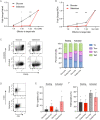This is a preprint.
Improved CAR-T cell activity associated with increased mitochondrial function primed by galactose
- PMID: 37808778
- PMCID: PMC10557609
- DOI: 10.1101/2023.09.23.559091
Improved CAR-T cell activity associated with increased mitochondrial function primed by galactose
Update in
-
Improved CAR-T cell activity associated with increased mitochondrial function primed by galactose.Leukemia. 2024 Jul;38(7):1534-1540. doi: 10.1038/s41375-024-02257-z. Epub 2024 May 7. Leukemia. 2024. PMID: 38714877
Abstract
CD19 CAR-T cells have led to durable remissions in patients with refractory B-cell malignancies; nevertheless, most patients eventually relapse in the long term. Many interventions aimed at improving current products have been reported, with a subset of them focusing on a direct or indirect link to the metabolic state of the CAR-T cells. We assessed clinical products from an ongoing clinical trial utilizing CD19-28z CAR-T cells from patients with acute lymphoblastic leukemia. CAR-T clinical products leading to a complete response had significantly higher mitochondrial function (by oxygen consumption rate) irrespective of mitochondrial content. Next, we replaced the carbon source of the media from glucose to galactose to impact cellular metabolism. Galactose-containing media increased mitochondrial activity in CAR-T cells, and improved in vitro efficacy, without any consistent phenotypic change in memory profile. Finally, CAR-T cells produced in galactose-based glucose-free media resulted in increased mitochondrial activity. Using an in vivo model of Nalm6 injected mice, galactose-primed CAR-T cells significantly improved leukemia-free survival compared to standard glucose-cultured CAR-T cells. Our results prove the significance of mitochondrial metabolism on CAR-T cell efficacy and suggest a translational pathway to improve clinical products.
Keywords: CAR-T; chimeric antigen receptor; galactose; immunotherapy; metabolism; mitochondria.
Conflict of interest statement
Competing Interests statement: The authors report no financial conflict of interests. This work was funded by the Dotan center for hematologic malignancies grant (EJ) and NIH grant 5R01CA259635 (TY).
Figures




References
Publication types
Grants and funding
LinkOut - more resources
Full Text Sources
